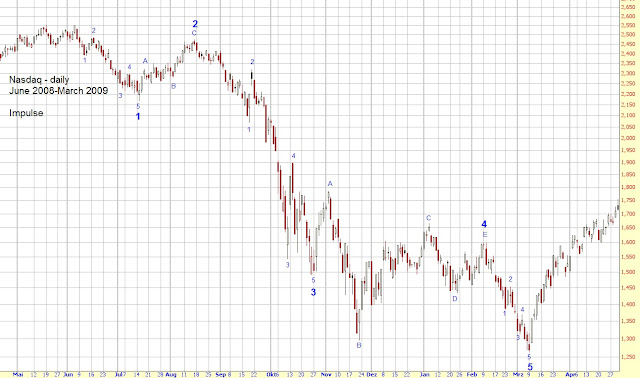There are two types of motive waves: impulses and diagonals. Three rules hold true for both types:
- Wave 2 never retraces more than 100 % of wave 1
- Wave 3 is never the shortest wave
- Wave 4 never retraces more than 100 % of wave 3
2.1 Impulse
The impulse is the most common motive wave and subdivides into five waves. Waves 1, 3, and 5 are motives themselves. Moreover, wave 4 doesn't enter the price territory of wave 1.
Example #1:
A very nice example of an impulse which occurred during the 03-07 bull market.
Example #2:
Another nice example of an impulse. The subwaves of waves 3 and 5 might be a bit tricky to identify but the whole five-wave-structure should be very obvious.
Example #3:
The start of the financial crisis.
Example #4:
The big crash in 2008 was part of an impulse which started already a few months earlier.
Diagonal
A diagonal is similar to an impulse with the exception that wave 4 does enter the price territory of wave 1. Moreover, wave 1 is longer than wave 3 and wave 3 is longer than wave 5. As a result, diagonals take on the shape of a wedge.
Ending diagonals terminate an impulse of one larger degree and occur in the fifth wave position. They form a wedge and each subwave subdivides into three waves.
 |
Sometimes ending diagonals also occur in the C wave position to complete a correction.
Example #1:
Example #2:
Leading Diagonal
Leading diagonals appear at the start of an impulse and occur in the first wave position. They differ from ending diagonals in that the actionary waves 1, 3, and 5 sometimes subdivide into five waves.
 |
Sometimes leading diagonals also occur in the A wave position at the start of a correction.
Example #1:
Wave 1 of the impulse I showed you in Example #2 in the impulse section is a leading diagonal.
Key notes:
- Two types of motives: impulses and diagonals
- Three rules apply for both types (see above)
- Diagonals differ from impulses in that wave 4 enters the price territory of wave 1
- Two types of diagonals: leading and ending
In the next chapter you'll learn the different types of corrective waves.
<< Previous Chapter Next Chapter >>
Exercises
Exercise #1:
Try to label this impulse:
Suggested solution
Exercise #2:
Another impulse:
Suggested solution
Exercise #3:
Suggested solution
Exercise #4:
Suggested solution
Exercise #5:
Suggested solution
<< Previous Chapter Next Chapter >>













